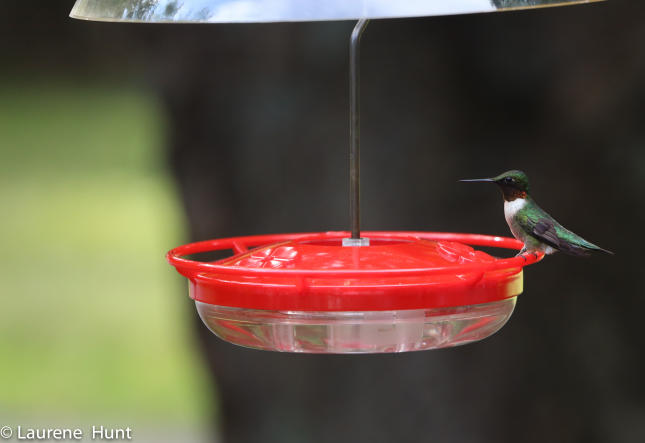Hummingbirds Have Been Spotted In Massachusetts!

Yay - according to Hummingbird Central (the Hummingbird Spring Migration Map), hummingbirds have been spotted in North Dighton, Plymouth and Brewster, Massachusetts! If you feed hummingbirds, it's time to make some nectar and put your feeders out!
Ruby-throated Hummingbirds are the only hummingbird species that breeds in the eastern United States. It may seem early for hummingbirds to be returning to New England and it is, but the lack of strong storms in recent days is making it easier for them advance north.
The first Ruby-throated Hummingbirds to arrive in the spring are generally males and they are often still migrating north…sometimes all the way to southeastern Canada. You can really help these early arrivals by putting up a Hummingbird feeder filled with nectar (see below for recipe), as their favorite tubular flowers are not yet flowering. Hummingbirds will drink from sap wells created by woodpeckers when flowers or feeders are hard to come by. The sugar/water ratio in sap is similar to that found in flowers and our feeder nectar. Hummingbirds also feed on insects including small beetles, flies, gnats, aphids, spiders and yes… mosquitos!
Ruby-throated Hummingbirds winter in Mexico and Central America and migrate north to raise their young. Hummingbirds are not monogamous. Males will mate with numerous females inside their territory. It is the female who builds the nest and raises the young. Females raise 1-2 broods during the breeding season and sometimes as many as 3. The female will sometimes build a second nest while still feeding her chicks in the first nest. Brood size is two pea-size eggs, which the female incubates for 11-16 days. Chicks are full grown when they fledge in about 20-22 days.
Ruby-throated Hummingbirds are 3-4 inches long and weigh about 1/8 of an ounce. Males sport the bright red throat (or gorget) the species is named for, have a black mask, green crown, back and wings and are greyish below. Females are mostly white below and on the throat, have a greyish mask and a green crown, back and wings.
To survive the cold nights (and sometimes days) of early spring, Hummingbirds go into a hibernation-like sleep called torpor. Their body temperature and heart rate drop and their breathing slows so much that they appear to have stopped breathing.
Hummingbirds! They’re tiny but tough! Help them have a successful breeding season by putting up a nectar feeder!
It’s Easy To Make Hummingbird Nectar!
Hummingbird Nectar Recipe:
1) Boil 4 parts water or use hot water from the tap.
2) Mix in 1 part ordinary white-granulated sugar.
3) Stir until the sugar is dissolved and let the mixture cool.
4) When the nectar reaches room temperature, fill your clean Hummingbird feeder.
Tips:
1) Never use red dyes or food coloring as they are not healthy for Hummingbirds.
2) Only use regular white table sugar. Never use honey as it can cause dangerous fungal growth. Organic, natural and raw sugars contain harmful levels of iron. Artificial sweeteners can also be harmful to birds.
3) Replace the nectar every 3-4 days and clean the feeder thoroughly. When days become hot you will have to replace the nectar more frequently as sugar water ferments and dangerous mold, fungus and bacteria grow in fermenting nectar.
4) Save time by making extra nectar. Unused nectar can be refrigerated for up to two weeks.
Enjoy the Hummingbirds!!

